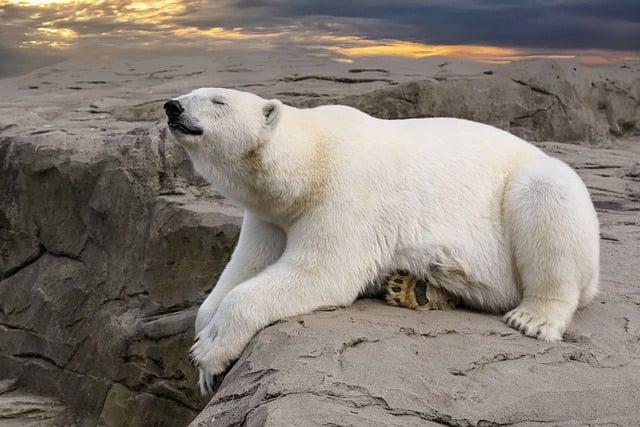- Introduction
- Arctic Updates
- Antarctic Updates
- Impact of Climate Change
- Wildlife Adaptation
- Conclusion
- FAQs
Introduction
The polar regions, including the Arctic and Antarctic, are experiencing significant changes due to various environmental factors. In this article, we will explore recent updates from both the Arctic and Antarctic regions. We will also delve into the impact of climate change on these areas, how wildlife is adapting to the changing conditions, and ultimately draw conclusions based on the current trends.
Arctic Updates

(Image: Pixabay/@girlart39)
The Arctic region is undergoing rapid transformations, with record-breaking temperatures and melting ice caps. Scientists have observed a decrease in sea ice extent, which has repercussions not only for the environment but also for global weather patterns. The opening of new shipping routes through the Arctic waters has highlighted the increased accessibility due to melting ice.
Furthermore, the Arctic ecosystem is facing challenges as species struggle to adapt to the changing habitat. The loss of sea ice affects the availability of food sources for marine animals, leading to disruptions in the food chain. This, in turn, impacts indigenous communities that rely on these resources for their livelihoods.
Efforts are being made to monitor these changes closely and understand their implications for both the local populations and the global climate system. It is essential to continue studying the Arctic region to mitigate the effects of these transformations effectively.
Antarctic Updates

(Image: Pixabay/@Eknbg)
In contrast to the Arctic, the Antarctic region is experiencing its own set of changes. While Antarctica is predominantly covered in ice, warming temperatures have led to the disintegration of large ice shelves. The melting ice in Antarctica contributes to rising sea levels, posing significant risks to coastal areas worldwide.
Scientists are studying the dynamics of ice loss in Antarctica to better predict future sea-level rise and understand the mechanisms driving these changes. The unique ecosystems in Antarctica, including diverse marine life, face threats from shifting environmental conditions, emphasizing the need for conservation efforts.
Research stations in Antarctica play a crucial role in monitoring climate indicators, studying wildlife populations, and conducting experiments to improve our knowledge of this remote region. International collaboration is key in advancing scientific research and preserving the integrity of Antarctica's delicate ecosystems.
Impact of Climate Change

(Image: Pixabay/@dassel)
Climate change is a driving force behind the transformations observed in the polar regions. The increasing greenhouse gas emissions are leading to global warming, resulting in the melting of ice caps, rising sea levels, and shifts in weather patterns. These changes have far-reaching consequences for both the environment and human societies.
By studying the impacts of climate change in the Arctic and Antarctic, scientists aim to raise awareness about the urgency of mitigating carbon emissions and implementing sustainable practices. Understanding the interconnectedness of ecosystems and the planet's climatic systems is vital for developing effective strategies to combat climate change.
Educational initiatives and public engagement are essential in fostering a collective responsibility to protect the polar regions and preserve them for future generations. It is imperative to act decisively to limit the negative impacts of climate change and safeguard the fragile ecosystems of the Arctic and Antarctic.
Wildlife Adaptation

(Image: Pixabay/@StockSnap)
Wildlife in the polar regions is resilient but faces unprecedented challenges as their habitats undergo rapid transformations. Species such as polar bears, penguins, and seals are adapting to the changing environment by altering their behaviors and migration patterns. However, the pace of climate change may outstrip their ability to adjust, putting these iconic animals at risk.
Conservation efforts play a vital role in protecting vulnerable species and ensuring their survival in the face of climate-related pressures. Monitoring wildlife populations, preserving critical habitats, and reducing human impacts on these ecosystems are critical steps in supporting the adaptation of polar wildlife to changing conditions.
Collaborative research initiatives between scientists, conservationists, and local communities are essential in developing sustainable solutions that balance environmental conservation with human needs. By working together, we can help safeguard the rich biodiversity of the polar regions and contribute to the long-term health of these unique ecosystems.
Conclusion
In conclusion, the Arctic and Antarctic regions are undergoing significant changes driven by climate change. The melting of ice caps, rising temperatures, and shifting ecosystems underscore the urgency of addressing global warming and its impacts on these critical areas. By raising awareness, conducting scientific research, and implementing sustainable practices, we can work towards preserving the polar regions for future generations.
FAQs
How is climate change affecting wildlife in the Arctic and Antarctic?
Climate change is impacting wildlife in the polar regions by altering habitats, food sources, and migration patterns. Species such as polar bears, penguins, and seals are facing challenges as their environments change rapidly.
What are the implications of melting ice in the Arctic and Antarctic on sea levels?
The melting of ice in the Arctic and Antarctic contributes to rising sea levels, posing threats to coastal areas worldwide. This phenomenon has the potential to disrupt ecosystems, endanger wildlife, and affect human populations living in vulnerable regions.
How can individuals contribute to the conservation of the polar regions?
Individuals can support the conservation of the polar regions by reducing their carbon footprint, advocating for sustainable policies, and supporting organizations involved in environmental protection efforts. Small actions collectively make a difference in preserving these unique ecosystems.

